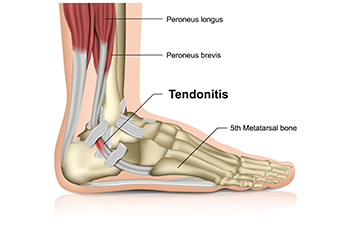
The Achilles tendon is the strongest tendon in the body, connecting the calf muscles to the heel bone, yet it is prone to painful injuries. Achilles tendinopathy is a condition marked by stiffness, swelling, and discomfort along the tendon, often caused by overuse or repetitive stress. A sudden rupture, or break, occurs when the tendon tears, usually with sharp pain and difficulty walking or pushing off the foot. These injuries typically occur in the back of the ankle, just above the heel. A podiatrist can provide a thorough evaluation, advanced treatments, and guidance for safe recovery. If you are experiencing Achilles tendon pain or have sustained an injury, it is suggested that you consult this type of doctor who can accurately diagnose and effectively treat this condition.
Achilles tendon injuries need immediate attention to avoid future complications. If you have any concerns, contact Adam Klein, DPM of Lynbrook, NY. Our practitioner can provide the care you need to keep you pain-free and on your feet.
What Is the Achilles Tendon?
The Achilles tendon is a tendon that connects the lower leg muscles and calf to the heel of the foot. It is the strongest tendon in the human body and is essential for making movement possible. Because this tendon is such an integral part of the body, any injuries to it can create immense difficulties and should immediately be presented to a doctor.
What Are the Symptoms of an Achilles Tendon Injury?
There are various types of injuries that can affect the Achilles tendon. The two most common injuries are Achilles tendinitis and ruptures of the tendon.
Achilles Tendinitis Symptoms
- Inflammation
- Dull to severe pain
- Increased blood flow to the tendon
- Thickening of the tendon
Rupture Symptoms
- Extreme pain and swelling in the foot
- Total immobility
Treatment and Prevention
Achilles tendon injuries are diagnosed by a thorough physical evaluation, which can include an MRI. Treatment involves rest, physical therapy, and in some cases, surgery. However, various preventative measures can be taken to avoid these injuries, such as:
- Thorough stretching of the tendon before and after exercise
- Strengthening exercises like calf raises, squats, leg curls, leg extensions, leg raises, lunges, and leg presses
If you have any questions please feel free to contact our office located in Contact Us . We offer the newest diagnostic tools and technology to treat your foot and ankle needs.
